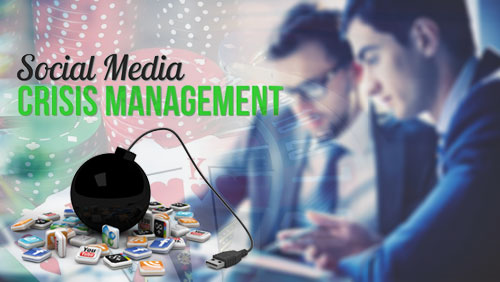This is a guest contribution by Stephen Padveen, a Senior Partner with t2Marketing International. . You can connect with t2Marketing International at one of their upcoming appearances. If you would like to submit a contribution please contact Bill Beatty for submission details. Thank you.
 When it comes to online gaming, players can be sensitive to even the smallest of issues. What’s more, the reality of the industry is such that players can easily move from one operator to another with little inconvenience to their playing experience. So when a potential crisis begins to rear its head, your casino needs to have a proper strategy in place in order to prevent the issue from spiraling out of control and becoming a viral conversation.
When it comes to online gaming, players can be sensitive to even the smallest of issues. What’s more, the reality of the industry is such that players can easily move from one operator to another with little inconvenience to their playing experience. So when a potential crisis begins to rear its head, your casino needs to have a proper strategy in place in order to prevent the issue from spiraling out of control and becoming a viral conversation.
The advent of social media in the world of communications has resulted in information travelling at unprecedented speeds. When a problem comes up, it can take as a little as a few minutes to make the rounds before you have a crisis on your hands that threatens the reputation and, in extreme cases, the survival of your brand. Therefore, it is crucial that your business has a comprehensive social media crisis management strategy so that crises can be identified in their infancy and dealt with before they expand.
There are a number of components that will go into a social media crisis management program but there are certain universal elements that every brand should take into consideration when developing policies and best practices.
Start by Listening
This might seem somewhat intuitive, but social listening is far more than simply watching your feeds and streams for comments. In order to effectively listen to online chatter, gaming operators should be using high-level listening tools in order to pay attention to trends, observe volume spikes, monitor sentiment changes and scrutinize comments regarding their brand as well as those of competitors and the industry in general.
Numerous listening tools assist in monitoring for conversation spikes or negative mentions which in turn can help you pre-empt damaging and destructive comments centered around your brand. Moreover, monitoring the chatter surrounding your competitors might also lead to opportunities when it comes to converting players to your property.
Identify Where the Problem has Originated
Again, you might think that this is a given, but conversation on social media can often be misleading. Users may, for no significant reason, begin lambasting your brand and threaten to play elsewhere. In 140 characters, a player can do a lot of damage without saying very much and even worse, they may omit the real reason for their displeasure. At that point, it is your responsibility to identify the origin of the problem.
When developing a strategy for handling your social media crises, it is important that your first outline what exactly constitutes a crisis. One or two negative reviews, or a very minor bump in negative mentions does not necessarily mean that a crisis is unfolding. At the same time, ignoring early stage downward trends in sentiment surrounding your brand can lead to much bigger problems if the issues are not identified and resolved early on in the conversation.
When you do see a fire beginning to burn, trace that issue back to its origin in order to determine if it is a quick fix or if you need to divert additional resources in order to handle it.
Sakichi Toyoda and Taiichi Ohno of Toyota first used the process of The 5 Whys in order to determine the root cause of a problem in their lean manufacturing process. This process is highly applicable to crisis management and a good technique to adopt when trying to pinpoint the root of an unfolding crisis. Ask yourself “why” five times backwards to determine where a problem started and how it has evolved to get to its current status. This will help you identify the root of the problem and resolve it in a timely manner to the satisfaction of your players.
For example, in reverse order, starting with the immediate problem;
- Why are players commenting negatively about my casino on social channels?
- They claim that customer service is poor.
- Why do they feel customer service is poor?
- Our customer support team is not answering questions in a timely manner
- Why is it taking so long to respond to players?
- Our support team is under staffed
- Why do we not have enough support team members?
- We have placed a higher priority on game development
- Why has game development been more important that customer support?
- We want to be the operator with the most games
And there you have it. Using the 5 Whys you can trace back to the root of the problem and identify ways to fix it. Ultimately, this can help you deal with the social crisis by informing players that you are expanding your customer support team in order to offer improved response times.
While this might be a simplification of the issue, it does help identify the origin of the problem and present ways to resolve it internally thereby avoiding a further crisis while improving the overall operational efficiency of your business.
Determine Priorities
So, you’ve identified the problem and what caused it, now it’s time to establish the priorities for handling the crisis. As part of your strategy, you need to determine the circumstances that dictate whether you respond to posts individually or issue a general statement with regards to how you plan to resolve the issue at hand.
Internally, every department should have clearly defined responsibilities in order to ensure that the issue does not continue to grow and instead remains contained. Who is responsible for determining the level or urgency? Who determines when you respond? Who is responsible for developing the content to be used in responding?
On social media, one of the most crucial priorities will be response time. In a time of crisis, players are going to be less understanding so addressing the issue publicly (again, either individually, globally or both) is going to be a top priority in any case.
Determine Your Response Type
There are two response types that can be used in the time of a crisis: offensive and defensive. There are successful examples of both, and you will need to decide which one is appropriate based on the type of issue you are facing.
When on the defensive, you own up to your mistakes, apologize for what has taken place and assure customers that the issue is being resolved and it will not happen again. This is often the right response in a case where your brand has been featured in a negative way – a PR crisis – or a product has crashed. On the other hand, when it comes to the offensive, you need to be very careful.
When going on the offensive, you need to be extra vigilant in crafting your response. A new layout, or a product overhaul, for example, are times when a brand might go on the offensive in response to complaints posted about new functionality or features. Users might not like certain changes at first, but by providing clear explanations in your response as to why this innovation will enhance their playing enjoyment, players can be converted to advocates and help avoid a larger crisis.
Conclusion
How a social media crisis is handled will vary not only from operator to operator, but from instance to instance. Not every crisis is going to be of the same magnitude and the best way to prepare for these problems is to have strategies in place with scenarios outlined for every foreseeable issue. This might sound like a lot of planning but it takes a lost less effort than you might think and in the end, it will definitely pay dividends.
Crises on social media can be fairly intimidating. This is especially true when, at first, all you can do is watch as you try to determine what has happened. But the more prepared your brand and the clearer direction you have at the outset of a crisis, the easier it will be to manage.
t2 Marketing International is a fully integrated marketing and communications firm with a 25-year history, including 19 years in digital marketing and over 8 years in social marketing.
t2 will be giving a Keynote Presentation at ICE on Feb 2nd titled “Improving Customer Service by Adopting Social Media as the Core of Your Customer Strategy”.
For more information on t2, please visit www.t2marketinginternational.com or contact Stephen Padveen at [email protected]




